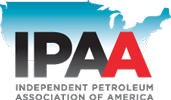Drilling
The Modern Oil and Gas Rotary Drilling Rig

Although the science of geology has advanced during the past decade, the only accurate way to determine whether or not crude oil or natural gas is present is to drill.
The most common type of land-drilling rig is the cantilevered mast. Sometimes called a jackknife derrick rig. When assembling this rig, the outside structure, made of prefabricated sections, is joined together with large pins. The engine and derrick sections are put into position and pinned together by the drilling crew. Next, the drawworks and engines are put in place. Finally, the derrick sections are laid out horizontally and raised as a unit by the hoisting line, traveling block and drawworks.
In rotary drilling, a bit used to cut the formation is attached to steel pipe called drillpipe. The bit is lowered to the bottom of the hole. The pipe is rotated from the surface by means of a rotary table, through which is inserted a square or hexagonal piece of pipe called a kelly. The turning action of the rotary table is applied to the kelly, which in turn rotates the drillpipe and the drilling bit. Routine drilling consists of continuously drilling increments the length of one joint of pipe, making connections or adding to the drillstring another single joint of pipe, generally 30 or 45 ft. long. This drilling continues until the drill bit must be changed. Changing the bit is also called making a “trip.” A round trip is simply coming out of the hole, changing the bit, and going back into the hole.
The principal components of a rotary rig are (1) the mast, (2) the drawworks, (3) the engines, (4) the mud system and (5) the drillstring. The mast or derrick is the structure placed over the well to help remove the pipe from and lower equipment into the hole. The drawworks is the hoisting equipment. The engines drive the mud pumps, drawworks and provide power for miscellaneous requirements like electricity. The mud system is comprised of the mud pumps, mud tanks, the mud flow lines and the circulating hose. The drillstring is the entire rotating assembly and consists of the kelly, drillpipe, drill collars and drill bit. At the bottom of the hole, the cuttings, or pieces of formation cut loose by the drilling bit, are removed from the hole continuously through the circulation of drilling mud or fluid: it cools and lubricates the bit and plasters the wall of the hole, making the hole more stable; and its hydrostatic pressure prevents the flow of salt water, oil and gas into the wellbore, helping prevent blowouts.

Royalty Owners | Operations: Drilling | Horizontal Drilling | Completion | Oil & Gas Revenue


